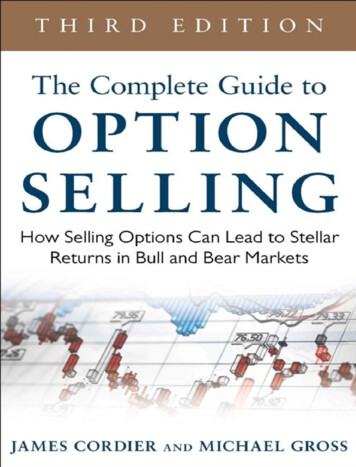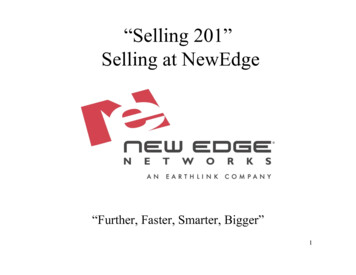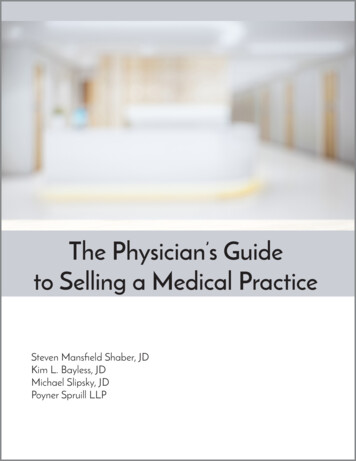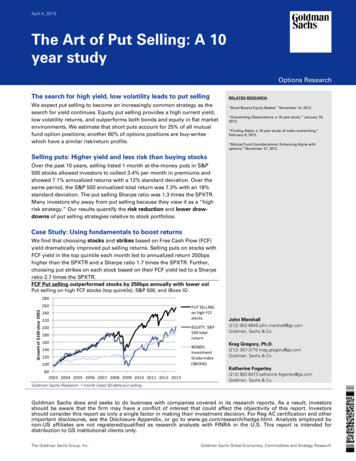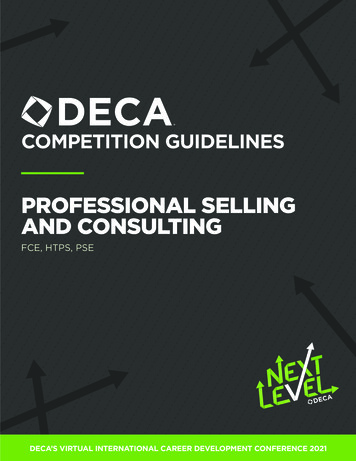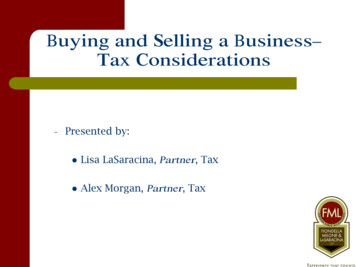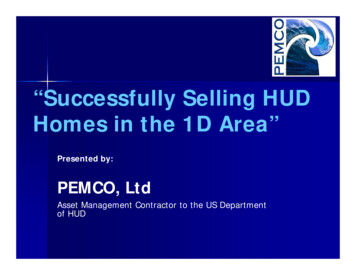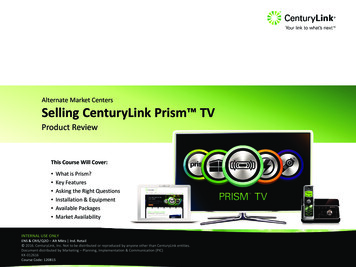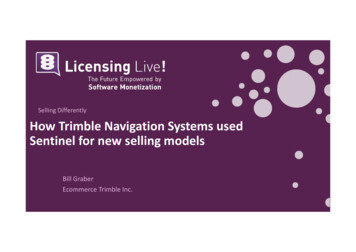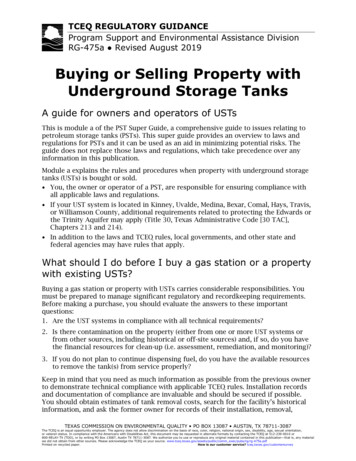
Transcription
A Guide to SellingFinal Expense Life InsuranceAGENT USE ONLYLS057 H1412
Table of ContentsTalk about Solving Problems – Not Life Insurance .1Sales Process.2Two Cycles that Represent the Sale .4Selling Cycle.6Pre-approach .8Approach .9Talk About Life – Not Life Insurance .12Bridging to a Discussion about Financial Needs .13Ideal Seating Arrangement .15“WIIFM” What’s In It For Me? .16Responding to Prospect’s Questions .17“Feel, Felt, Found” .18Handling Objections .20Other Techniques for Dealing with Reluctance to Purchase .21Your Job as a Translator .23Taking Action .24Closing Techniques.25Trial Closing .26More about “The Close” .30Motivational Stories .34“The Close” is just a Logical Conclusion .36Summarizing Your Proposal .37Obligation Close .38Live, Die or Quit Close .38Ben Franklin Close .39Tips on closing .40Let’s Review .41Objections .43Answering Objections .45What does “No” mean? .47Ann Landers’ Motivational Stories .48
A Guide to Selling Final Expense Life InsuranceTalk about Solving Problems – Not Life InsuranceLife insurance is a problem-solver, if the person with the problem is aware that they have a problem.Almost everyone has certain fundamental problems for which the life insurance we sell is the bestsolution.Most people are unaware that their loved ones may have had financial problems after death. Peoplelive in the moment rather than planning for the future, because it does not occur to them that they maynot always be around to provide for loved ones.Problems exist whether or not a person is conscious of it. People who are satisfied, complacent andundisturbed today do not believe they need life insurance. Why should they be concerned with asolution to a problem they believe does not exist? Often, the only reason a person does not buy lifeinsurance from you is because that person does not realize that he or she has a problem, or if he or shedoes, they are do not feel enough urgency to take action now.Therefore, the objective of an interview is essentially leading the prospect to realize that a financialproblem could arise, weighty and sobering danger could threaten, and that something should be doneabout it now.Before you can go very far in bringing to light the potential problems, however, you must not onlyunderstand what those problems are, but you must express that you are truly and seriously concernedwith the solution. You must first establish the general problems with your prospect, like those we allface. Later, you would get into specific problems that your client faces in his or her life. We are allready to agree on the truth of a general statement before we are willing to admit that the statementapplies to us specifically. We are ready to identify with a certain group and talk about the problemsof that group, but we become defensive when singled out, and it is pointed out that the problem underdiscussion is specifically our own. If you are planning to discuss the ability of life insurance to helpme solve the problem of having to pay final expenses due to death, you deal with me first as a groupmember rather than an individual.When most people are asked why they have life insurance, they will most likely tell you because theywant to protect their loved ones from financial burden. If that is the case, then it would make sense tofind out what exactly the loved ones will need and determine if their existent life insurance policy willmeet those needs. 2012 Legacy Safeguard, LLC. All Rights Reserved.FOR AGENT USE ONLY.Page 1
A Guide to Selling Final Expense Life InsuranceSales ProcessThe sales process is a series of actions you take to result in the purchase of a product or service. Theprocess begins with prospecting which results in an appointment for a convenient interview, if allgoes well. The interview gives you the opportunity to establish the need for financial protection.In most cases, the sales process continues with answering specific questions from the prospect.Almost all prospects will have questions, issues, and concerns that you will need to address beforethey decide to purchase. Some will have valid reasons for not accepting your insurance proposal.Answer every question confidently and professionally using the “Feel, Felt, Found” technique andothers described later in this guide.After answering a prospect’s questions, you are able to move to the final step of the sales process —the prospect’s commitment to take action. The next section focuses on how to answer questionsand obtain a commitment. These two critical activities finish the sales process by convincing theprospect to act now.The Importance of AttitudeMaintaining the right attitude throughout the sales process makes all the difference, especially whenanswering questions and attempting to obtain the commitment.Attitude is so critical at this point in the sales process, because during the final stages of the sale, theprospect will likely struggle to admit his or her own mortality and purchase life insurance. Never getfrustrated or angry at the prospect. It is very important to stay positive and focused if you want tohelp them act on their need for life insurance.Visualize the situation that exists as you attempt to finalize their commitment. Even at the finalmoment, almost all prospects will still have reservations, even if they do not express them to you. Ifyou show any sign of impatience, frustration, fatigue, or concern, it could influence the prospect not todo business with you.You must maintain a positive, confident attitude at all times. And you must also convey your sincerebelief in the idea that premiums paid now while the insured is alive and in good health, will providefinancial security for their loved ones at a later time -- that life insurance is very valuable. 2012 Legacy Safeguard, LLC. All Rights Reserved.FOR AGENT USE ONLY.Page 2
A Guide to Selling Final Expense Life InsuranceWhat actions can you take to adopt and maintain the proper attitude? The following is a list oftechniques for staying positive and focused as you answer questions and prepare to write theapplication:1.Deliver a compelling and structured presentation. Have a clear, rehearsed plan, and do not “wingit”! Use company-approved materials to conduct the interview. These materials are designed toprovide the critical content and structure of your presentation. They help you walk the prospectthrough an assessment of his or her needs, which can be one of the most effective arguments for lifeinsurance. They allow you to have control of the interview, which is just as important. When you arein control, you are able to instill confidence in the prospect.2. Believe that the prospect will purchase insurance. Before you even approach the prospect, youshould have complete confidence in your ability to help them believe that the decision to purchase lifeinsurance is right. Successful agents can gain confidence from months and years of experience. Ifyou are new, you can draw your confidence from the fact that you are making a powerful differencein the lives of people by opening their eyes to the value of life insurance.3. Focus on prospects instead of suspects. Do your best to make sure a prospect is qualified early inthe interview. Ask questions to determine whether the prospect has family (thus a real need for lifeinsurance), is able to pay for that insurance, and has a reasonable chance of meeting the company’sunderwriting guidelines. You will be more productive when you work with qualified prospects, andsuccess will increase your confidence dramatically. 2012 Legacy Safeguard, LLC. All Rights Reserved.FOR AGENT USE ONLY.Page 3
A Guide to Selling Final Expense Life InsuranceTwo Cycles that Represent the SaleBelow you'll see the Buying Cycle, and on the next page, the Selling Cycle. Of course, they arecounterparts to each other. When we make the decision to buy a product or service, we go through amental process illustrated in the Buying Cycle. We:1. Recognize the problem.2. Desire a solution.3. Decide on a particular solution.4. We buy, or more positively, buy now.BUYING CYCLE1RECOGNIZETHE NEEDPROBLEM4DESIRE ASOLUTIONBUY NOW2DECIDE ONASOLUTION3 2012 Legacy Safeguard, LLC. All Rights Reserved.FOR AGENT USE ONLY.Page 4
A Guide to Selling Final Expense Life InsuranceThe Selling Cycle coincides with the Buying Cycle. It is our job when we are selling to help theprospect:1. Identify the need or problem.2. Create a desire for a solution to that problem.3. Consider all of the available solutions.4. Close the sale; ask for a signature on the insurance application and the first premium.SELLING CYCLE1IDENTIFYTHE NEEDPROBLEM4CREATEDESIRE FORSOLUTIONCLOSETHE SALESSALE2CONSIDERSOLUTIONS3 2012 Legacy Safeguard, LLC. All Rights Reserved.FOR AGENT USE ONLY.Page 5
A Guide to Selling Final Expense Life InsuranceSelling CycleLet’s take a closer look at each step of the selling cycle: how the sale is made, how we motivate ourprospect to buy, and the thought process of the prospect when making a buying decision. The SellingCycle is a logical sequence that our prospect uses to make a closing decision, assuming that they haveenough information to influence them to confidently act now. All of these points make up the SellingCycle. Let's refer back to the Selling Cycle when we identify the problem. To begin, recognize thatyou are not the cause of the problem. Your job is simply to help bring the problem to light where itcan be solved effectively. At the appropriate stage in the Selling Cycle, you suggest a solution tocreate a feeling of peace in the client’s mind. At this point, we are only focusing on problems such asa inadequate income for the surviving family, a home mortgage, education for the grandchildren,unpaid taxes, debt liquidation or last expenses if someone should die. So, the first step in the SellingCycle is to identify the problem.Now, let's move to step two in the selling cycle, which is to create a desire for a solution. Ourmission is not to propose a solution yet, but to create a sense of urgency to solve the problems. Don'tmistakenly assume that your prospect will want your insurance solution right away after he or she hasseen the problem. This is where you probe to learn who will need protection or income, how muchthey will need, and when they will need it. When you understand what a client’s need entails, youcan help your prospect develop the best solution that suits them. This is quite possibly the mostimportant step in the Selling Cycle. This is where you will address the essential element in the sellingprocess: the need from the prospect’s point of view.Needs selling is very important. It differs from selling benefits, policy provisions or low premiums,because the need almost never goes away. So any time in the future, the policy could be resold forthe very same need rather than lapsing the insurance coverage. Needs selling is critical for policies tostay on a premium-paying basis longer. In the selling cycle, you light a fire to satisfy the mostessential need or needs.In the third quadrant of the Selling Cycle, we analyze the solutions. As an insurance agent, you helpyour client by figuring out solutions to the crucial financial problems pertinent to them. You mayoffer a graded benefit or a permanent solution. In step three of the Selling Cycle, discuss the meritsof the appropriate options as your prospect considers each solution. 2012 Legacy Safeguard, LLC. All Rights Reserved.FOR AGENT USE ONLY.Page 6
A Guide to Selling Final Expense Life InsuranceStep four of the Selling Cycle is the close. You help your prospect feel comfortable enough to buynow. The other three steps in the cycle should be covered thoroughly and in sequence before closing.You must have identified the problem, created a desire for the best solution to that problem, andconsidered the solution before asking for a signature on the application. You are then able to ask theprospect to buy. If you both have clearly identified and agreed upon the problem, the best way youcan help your prospect now is by completing the sale. Always help the client purchase what theclient wants, not what you want to sell. Make it a win/win result for both of you.If you follow the process in the Selling Cycle, the only logical answer to the question of whether ornot to buy for your client is yes. If you don't receive a positive answer, back track to the previoussteps in the Selling Cycle. Be sure that you and your prospect have identified the problem, createdthe need for your products, and that there is a true desire to solve that problem. Double-check thesolutions that you presented. Are they really appropriate? Finally, ask again for their commitment. 2012 Legacy Safeguard, LLC. All Rights Reserved.FOR AGENT USE ONLY.Page 7
A Guide to Selling Final Expense Life InsurancePre-approachThere are two effective pre-approach methods. The first is pre-approach mail and the other is to usethe telephone.Mailings can include company or personal letters, booklets, brochures or some other appropriatematerial organized to catch the prospect's interest. They may or may not offer to set aside a fewminutes for face-to-face dialogue with you. Pre-approach mail doesn’t necessarily have to ask for aresponse from the recipient. Results have shown overwhelmingly, however, that life insurance agentswho follow-up with every pre-approach mailing are more successful, whether or not they ask for aresponse by telephone or a face-to-face meeting.The second recommended pre-approach method is to use the telephone. A good telephone script,whether informal or memorized, allows you to do nothing more than introduce yourself, state yourbusiness and affiliation, indicate that you have something of interest to show, and attempts toschedule a face-to-face appointment. It is not a good idea to make a presentation at this time, becausepeople have a harder time understanding it on the telephone. We can also use the telephone methodwhether or not a pre-approach mailing preceded it. Its purpose should be to solely arrange anappointment. A few hours of practice in this pre-approach method will make you an expert forobtaining interviews on a regular basis.The approaches, which you will learn about in the next section of this guide, are non-threatening andcould work very well for you with your present policyholders. Although they may seemoverwhelming at first, once they are learned, they will make you successful. 2012 Legacy Safeguard, LLC. All Rights Reserved.FOR AGENT USE ONLY.Page 8
A Guide to Selling Final Expense Life InsuranceApproachThere are many avenues you can take to approach quality prospects.As mentioned before, your present policyowners are probably the easiest group for you to approachabout the need for life insurance, because you have established a relationship with them through otherhealth product activities. You have already proven yourself and gained trust. There should be nodoubt in their minds that you have their best interests in mind when talking about life insurance.Often you will be able to lead directly from a collection appointment, to a sales approach, and to asales interview, with just a simple conversational bridge like this:"You know, Mrs. Prospect, I have an idea I'd like to share with you and your husband that I thinkyou'll find of great value. Do you think we could all get together this evening at 6:45 to talk about it,or would 7:30 p.m. be better for you?"Notice that you have not asked the prospect whether or not you could come back later, but youassumed consent because of your relationship; so the only question is which time is more convenient.In other words, you've offered the prospect two positive choices and eliminated the chance to say no,which is an important psychological advantage for you.You also have certain advantages in approaching new prospects that are acquainted with currentpolicyholders. Neighbors of present policyowners may remember seeing you in the neighborhood.Good inquiries to make to current clients about others are the names, work status, what time bothspouses are usually at home, and other information like this that will qualify them as prospects andalso give you insight into the best time to call. Your present policy owners will gladly allow you touse their names when introducing yourself to their neighbors and friends. This third partyacquaintance can make it easier to smooth the way to your next sales interview by gatheringqualifying information. Try using this non-threatening and effective approach:"Mr. and Mrs
provide the critical content and structure of your presentation. They help you walk the prospect through an assessment of his or her needs, which can be one of the most effective arguments for life insurance. They allow you to have control of the interview, which is just as important. . A Guide to
